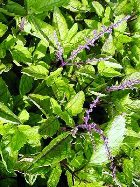
Plant Part: Aerial Part
Extraction: Steam Distilled
Growing Practice: Organic
Country of Origin: S. India
Odor Type: SPICY
Odor Characteristic: Sweet-spicy, warm and aromatic, with faint balsamic-woody undertones and a fresh, green quality. Some basils have an anisec note. Dryout is greenish-woody with slight anesic note.
Refractive Index: 1.47950 to 1.48950 @ 20.00 °C.
Specific Gravity: 0.89000 to 0.93000 @ 25.00 °C.
Appearance: pale yellow to yellow colour liquid
CAS No: 8015-73-4
INCI Name: OCIMUM SANCTUM LEAF EXTRACT
About the Plant
Ocimum sanctum comes from the family Lamiaceae often commonly called the Mint family is a tropical, much branched perennial or annual herb growing up to 18" tall. Common names for this plant include Holy Basil, Tulsi, Tulasi, Sri Tulsi, tulasi Chajadha, Thulasi, Krishna tulasi, etc. Holy Basil is found throughout India, ascending up to 4,000 ft. in the Himalayas and in the Andaman and Nicobar Islands. The plant has small leaves and a hairy stem with strong odor and purple flowers. There are both red and green varieties; the red being the strongest aromatically. It is not as leafy or bushy as most basils, but is appreciated for its fragrance.History
In Indian mythology the plant is considered to extirpate all sins and purify the body when touched. It is often grown outside dwellings and worshipped daily. It is said to daunt Yama, the god of death, but has a close affinity with Lord Krishna who is reputed to have grown the herb. If offered to Lord Krishna it is said to have mystical powers of protection from death, disease and misfortune. It is used in Thailand for culinary purposes. It is believed to be an incarnation of Tulsi the wife of Vishnu (one of three high gods in Hinduism) and is a symbol of fidelity. It is considered a symbol of fidelity and helpful in attaining spiritual enlightenment. It has been used to support a healthy response to stress, maintain blood sugar levels within a normal range, promote longevity, nourish the mind and elevate the spirit. Other traditional properties include it's use as a carminative, vermifuge, febrifuge, bronchial dilator, diaphoretic, anti-bacterial, anti-inflammatory and as an insecticidal especially against mosquitoes.Perfumery:Sweet basil essential oil is a classic perfume material and adds interesting notes to chypres, crepe de chines and certain modern green perfumes. It blends especially well with opopanas and bergamot, clary sage, lime and oakmoss. Suggested dilutions are .30 to mg% with a minimum perceptible range of .04 to .10 mg%.
Herbal: In Suriname, the juice of the leaves is used for fever and as an antidote for snake and scorpion bites. It has anti-spasmodic properties, relieving abdominal pain and helps lower blood sugar level.
Apart from the religious significance, it also has substantial medicinal meaning and is used in Ayurvedic treatment. Tulasi has antimicrobial properties since it is also anti - inflammatory due to the oil eugenol, present in the leaves. It is useful in respiratory tract infection. The Ursolic acid present in holy basil, has anti-allergic properties. The plant can play a role in the management of immunological disorders such as allergies and asthma.
This peer-reviewed paper has referenced herbal research and applications of the alcohol tincture submitted by E. Indian researchers:
http://www.pharmainfo.net/reviews/ocimum-sanctum-and-its-therapeutic-applications
This report was written by Steven Maimes - SALAM Research, Rochester, NH, to advance the understanding of the uses and benefits of the herb Holy Basil Ocimum sanctum.
http://www.holy-basil.com/MaimesReportHolyBasil-1.pdf![]()
The information provided on these pages is not a substitute for necessary medical care, nor intended as medical advice. Always keep aromatic extracts tightly closed and in a cool, dark place, out of reach of children. Never ingest aromatic extracts. Always dilute aromatic extracts when applying topically and avoid areas around eyes or mucous membranes. If redness or irritation occurs, stop using immediately and contact your health provider if necessary.![]()
all images and content copyright ©2000—2020 by suzumebachi design and samara botane





